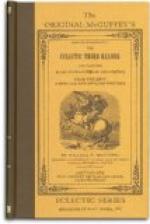14. Days, months, years, and ages shall circle
away,
And still the
vast waters above thee shall roll;
Earth loses thy pattern forever
and aye;
O sailor boy!
sailor boy! peace to thy soul!
Definitions.—1. Ham’mock, a hanging or swinging bed, usu-ally made of netting or hempen cloth. 4. Trans’port, ecstasy, rapture. 5. Im-pearled’ (pro. im-perled’), decorated with pearls, or with things resembling pearls. 7. ’Lar’ums (an abbreviation of alarums, for alarms), affrights, terrifies. 12. Dirge, funeral music.
Notes.—13. Coral is the solid part of a minute sea animal, corresponding to the bones in other animals. It grows in many fantastic shapes, and is of various colors.
Amber is a yellow resin, and is the fossilized gum of buried trees. It is mined in several localities in Europe and America; it is also found along the seacoast, washed up by the waves.
CV. THE PASSENGER PIGEON.
John James Audubon (b. 1780, d. 1851). This celebrated American ornithologist was born in Louisiana. When quite young he was passionately fond of birds, and took delight in studying their habits. In 1797 his father, an admiral in the French navy, sent him to Paris to be educated. On his return to America, he settled on a farm in eastern Pennsylvania, but afterward removed to Henderson, Ky., where he resided several years, supporting his family by trade, but devoting most of his time to the pursuit of his favorite study. In 1826 he went to England, and commenced the publication of the “Birds of America,” which consists of ten volumes—five of engravings of birds, natural size, and five of letterpress. Cuvier declares this work to be “the most magnificent monument that art has ever erected to ornithology.” In 1830 Audubon returned to America, and soon afterwards made excursions into nearly every section of the United States and Canada. A popular edition of his great work was published, in seven volumes, in 1844, and “The Quadrupeds of America,” in six volumes,—three of plates and three of letterpress, in 1846-50. He removed to the vicinity of New York about 1840, and resided there until his death.
1. The multitudes of wild pigeons in our woods are astonishing. Indeed, after having viewed them so often, and under so many circumstances, I even now feel inclined to pause and assure myself that what I am going to relate is a fact. Yet I have seen it all, and that, too, in the company of persons who, like myself, were struck with amazement.
2. In the autumn of 1813 I left my house at Henderson, on the banks of the Ohio, on my way to Louisville. In passing over the Barrens, a few miles beyond Hardinsburgh, I observed the pigeons flying, from northeast to southwest, in greater numbers than I thought I had ever seen them before, and feeling an inclination to count the flocks that might pass within the reach of my eye in one hour, I dismounted, seated myself on an eminence, and began to mark with my pencil, making a dot for every flock that passed.




